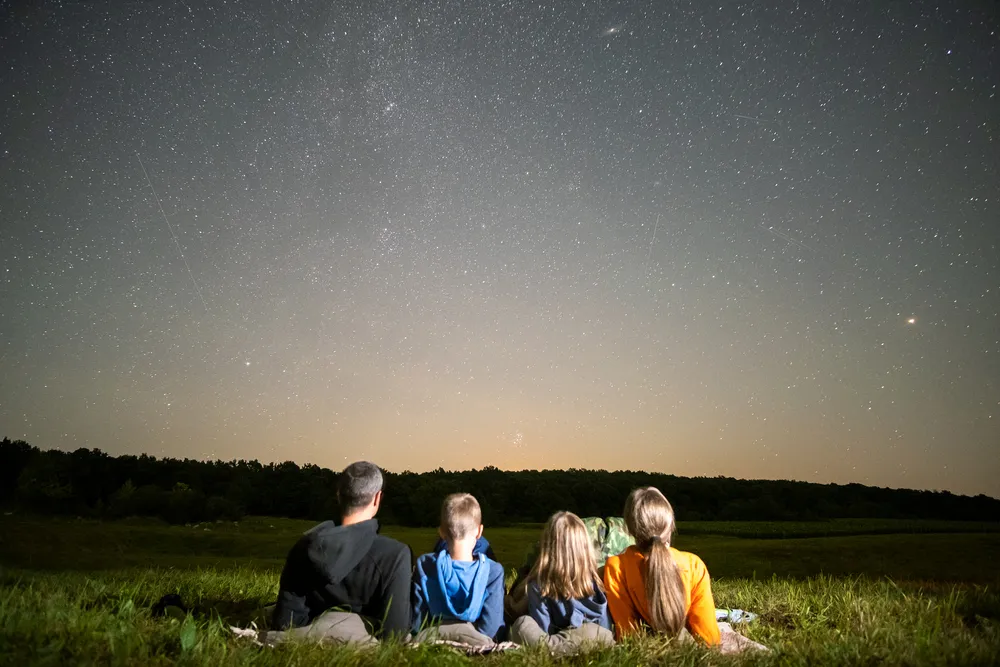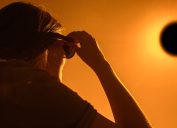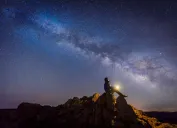Meteors With "Glowing Trains" Will Light Up the Sky This Weekend—How to See Them
The Orionids are considered "one of the most beautiful" meter showers of the year, NASA says.

If this past weekend's annular eclipse reminded us of anything, it's that people still jump at the chance to witness a special celestial event. But while there may not be another total solar eclipse for a few months, there are still some upcoming spectacles that are worth adding to your calendar. That includes this weekend when the Orionids will bring meteors with "glowing trains" that light up the sky. Read on for more information on how you can see the dazzling display for yourself.
RELATED: Intense Solar Storms May Peak Faster Than Expected—What That Means for Earth.
"One of the most beautiful" meteor showers of the year will peak this weekend.

Stargazers looking for a reason to spend some time outdoors will have a pretty good excuse in the coming days. That's because the Orionids are scheduled to peak over the weekend in what is considered to be "one of the most beautiful" meteor showers of the entire year, according to NASA.
The annual event earned its reputation thanks to its "fast" meteors that are "known for their brightness and speed." Their high velocity causes them to leave "glowing trains" in their wake that can last for several seconds or even minutes in the sky, per the space agency. And between streaks of light, they can also appear as "fireballs" that create explosions of light in the night sky, per the space agency.
RELATED: 6 Stargazing Secrets, According to Astronomy Experts.
Conditions for the shower are created by a very famous celestial source.

Besides their notable beauty, the Orionids also stand out thanks to their origin story. The annual shower is the result of Earth passing through the debris trail left behind by Halley's comet—scientifically known as 1P/Halley—which has become a household name for its high-profile fly-bys of our planet, according to NASA.
Even though there are reported sightings of the comet dating back to 240 CE, the object didn't actually get its name until Edmond Halley correctly calculated its appearance every 76 years, astronomy website EarthSky reports. And while it last skimmed Earth in 1986 and won't return until 2061, its remnants still create "shooting stars" with the Orionids each October and with the Eta Aquarids every May.
RELATED: 30 Moon Facts That Are Out of This World.
Early Saturday and Sunday mornings will likely see the most meteor activity.

The Orionids provide a relatively long window for viewing, as they technically started back on Sept. 26 and are expected to carry through Nov. 22, per EarthSky. However, the meteor shower will reach its peak this weekend on Oct. 22, making early Saturday and Sunday mornings the best times to step outside.
Just plan on staying out pretty late: The ideal timeframe for activity is between 1 a.m. and dawn, according to the American Meteor Society (AMS). This is when the shower's radiant—the famous constellation Orion—will be more than 30 degrees above the horizon.
This year's shower will also be set up for success thanks to a half-illuminated first-quarter crescent moon that will set around midnight. The reduced light helps create ideal viewing conditions, which can mean as many as 10 to 20 visible meteors per hour in darker skies, according to AMS.
RELATED: 8 Amazing Things You Can See in the Night Sky Without a Telescope.
Here are a few ways to maximize your Orionids meteor experience.

Fortunately, the Orionids' long peak window makes it possible to work around any cloudy or unfavorable weather conditions that might pass through your area over the weekend. But there are still a few other things within your control that can make your meteor shower viewing experience even better.
As with any stargazing event, it's best to find a viewing spot in a dark area far away from the light pollution of cities and towns and with as much visibility of the sky as possible. It can also help to set up your chair, sleeping bag, or blanket with your feet facing southeast if you're in the Northern Hemisphere, according to NASA.
The space agency also points out that it can take up to 30 minutes in the dark for your eyes to adapt to the conditions. Once you're settled in, try to relax and stay patient while you wait for the dazzling meteors to pass overhead.
RELATED: For more up-to-date information, sign up for our daily newsletter.





















